4-Nitrophenol Efficient Photoreduction from Exfoliated and Protonated Phenyl-Doped Graphitic Carbon Nitride Nanosheets
Abstract
:1. Introduction
2. Materials and Methods
2.1. Materials
2.2. Synthesis of Phenyl-Carbon Nitride
2.3. Synthesis of Protonated Phenyl-Carbon Nitride (Hereafter pePhCN)
2.4. Characterization Techniques
2.5. Evaluation of Photocatalytic Activity
3. Results and Discussion
- (1)
- pePhCN was used as catalyst in copresence of hydrazine in the aqueous solution under light irradiation.
- (2)
- pePhCN was used as catalyst in copresence of hydrazine in the aqueous solution and the experiment was performed in the dark.
- (3)
- Pure PhCN was used as catalyst in copresence of hydrazine in the aqueous solution under light irradiation.
- (4)
- The experiment was performed without catalyst, with hydrazine and under light irradiation.
- As shown in Figure 8, pure phenyl carbon nitride did not exhibit any photocatalytic activity and no photoreduction happened by increasing the irradiation time. By modifying the surface of the catalyst with the protonation and exfoliation process, the photocatalytic activity was strongly increased and after 15–20 min the total reduction of 4-nitrophenol into 4-aminophenol was obtained. This improvement of the photocatalytic activity is attributed to the facile absorption of the 4-nitrophenolate anion in the positively charged surface of the catalyst. To confirm the crucial role of the catalyst we performed the same experiment in dark conditions with only hydrazine and, in both cases, we did not observe any photoactivity. Furthermore, the experiments were repeated without NH2NH2 (with light) and no photocatalytic activity was observed for PhCN and pePhCN.

4. Conclusions
Author Contributions
Funding
Institutional Review Board Statement
Informed Consent Statement
Data Availability Statement
Conflicts of Interest
References
- Patnaik, S.; Martha, S.; Parida, K.M. An overview of the structural, textural and morphological modulations of g-C3N4 towards photocatalytic hydrogen production. RSC Adv. 2016, 6, 46929–46951. [Google Scholar] [CrossRef]
- Mousavi, M.; Habibi-Yangjeh, A.; Pouran, S.R. Review on magnetically separable graphitic carbon nitride-based nanocomposites as promising visible-light-driven photocatalysts. J. Mater. Sci. Mater. Electron. 2018, 29, 1719–1747. [Google Scholar] [CrossRef]
- Pany, S.; Parida, K.M. A facile in situ approach to fabricate N,S-TiO2/g-C3N4 nanocomposite with excellent activity for visible light induced water splitting for hydrogen evolution. Phys. Chem. Chem. Phys. 2015, 17, 8070–8077. [Google Scholar] [CrossRef] [PubMed]
- Cao, S.; Low, J.; Yu, J.; Jaroniec, M. Polymeric Photocatalysts Based on Graphitic Carbon Nitride. Adv. Mater. 2015, 27, 2150–2176. [Google Scholar] [CrossRef]
- Li, Y.; Ruan, Z.; He, Y.; Li, J.; Li, K.; Jiang, Y.; Xu, X.; Yuan, Y.; Lin, K. In situfabrication of hierarchically porous g-C3N4 and understanding on its enhanced photocatalytic activity based on energy absorption. Appl. Catal. B Environ. 2018, 236, 64–75. [Google Scholar] [CrossRef]
- Kumaravel, V.; Imam, M.D.; Badreldin, A.; Chava, R.K.; Do, J.Y.; Kang, M.; Abdel-Wahab, A. Photocatalytic hydrogen production: Role of sacrificial reagents on the activity of oxide, carbon, and sulfide catalysts. Catalysts 2019, 9, 276. [Google Scholar] [CrossRef] [Green Version]
- Wan, J.; Pu, C.; Wang, R.; Liu, E.; Du, X.; Bai, X.; Fan, J.; Hu, X. A facile dissolution strategy facilitated by H2SO4 to fabricate a 2D metal-free g-C3N4/rGO heterojunction for efficient photocatalytic H2 production. Int. J. Hydrogen Energy 2018, 43, 7007–7019. [Google Scholar] [CrossRef]
- Yu, X.; Xie, J.; Liu, Q.; Dong, H.; Li, Y. The origin of enhanced photocatalytic activity in g-C3N4/TiO2 heterostructure revealed by DFT calculations. J. Colloid Interface Sci. 2021, 593, 133–141. [Google Scholar] [CrossRef]
- Porcu, S.; Castellino, M.; Roppolo, I.; Carbonaro, C.M.; Palmas, S.; Mais, L.; Casula, M.F.; Neretina, S.; Hughes, R.A.; Secci, F.; et al. Highly efficient visible light phenyl modified carbon nitride/TiO2 photocatalyst for environmental applications. Appl. Surf. Sci. 2020, 531, 147394. [Google Scholar] [CrossRef]
- Tahir, M.B.; Sagir, M.; Shahzad, K. Removal of acetylsalicylate and methyl-theobromine from aqueous environment using nano-photocatalyst WO3-TiO2@g-C3N4 composite. J. Hazard. Mater. 2019, 363, 205–213. [Google Scholar] [CrossRef] [PubMed]
- Palmas, S.; Castresana, P.A.; Mais, L.; Vacca, A.; Mascia, M.; Ricci, P.C. TiO2-WO3 nanostructured systems for photoelectrochemical applications. RSC Adv. 2016, 6, 101671–101682. [Google Scholar] [CrossRef] [Green Version]
- Huang, Y.; Li, K.; Lin, Y.; Tong, Y.; Liu, H. Enhanced Efficiency of Electron–Hole Separation in Bi2O2CO3 for Photocatalysis via Acid Treatment. ChemCatChem 2018, 10, 1982–1987. [Google Scholar] [CrossRef]
- Lu, Y.; Huang, Y.; Zhang, Y.; Cao, J.; Li, H.; Bian, C.; Lee, S.C. Oxygen vacancy engineering of Bi2O3/Bi2O2CO3 heterojunctions: Implications of the interfacial charge transfer, NO adsorption and removal. Appl. Catal. B Environ. 2018, 231, 357–367. [Google Scholar] [CrossRef]
- Wang, Z.; Huang, Y.; Ho, W.; Cao, J.; Shen, Z.; Lee, S.C. Fabrication of Bi2O2CO3/g-C3N4 heterojunctions for efficiently photocatalytic NO in air removal: In-situ self-sacrificial synthesis, characterizations and mechanistic study. Appl. Catal. B Environ. 2016, 199, 123–133. [Google Scholar] [CrossRef] [Green Version]
- Dong, F.; Wang, Z.; Li, Y.; Ho, W.K.; Lee, S.C. Immobilization of polymeric g-C3N4 on structured ceramic foam for efficient visible light photocatalytic air purification with real indoor illumination. Environ. Sci. Technol. 2014, 48, 10345–10353. [Google Scholar] [CrossRef] [PubMed]
- Huang, Y.; Gao, Y.; Zhang, Q.; Zhang, Y.; Cao, J.; Ho, W.; Lee, S.C. Biocompatible FeOOH-Carbon quantum dots nanocomposites for gaseous NOx removal under visible light: Improved charge separation and High selectivity. J. Hazard. Mater. 2018, 354, 54–62. [Google Scholar] [CrossRef]
- Abbasi, Z.; García-López, E.I.; Marcì, G.; Farrokhnia, A.; Shoushtari, M.Z. Photocatalytic degradation of 4-Nitrophenol by g-C3N4-MCy: Mechanism study and kinetic modeling. J. Photochem. Photobiol. A Chem. 2021, 407, 113004. [Google Scholar] [CrossRef]
- U.S. Environmental Protection Agency (USEPA). Quality Criteria for Water; EPA 440/5-86-001; Office of Water Regulation and Standard: Washington, DC, USA, 1986.
- Lai, G.H.; Huang, B.S.; Yang, T.I.; Tsai, M.H.; Chou, Y.C. Preparation of highly stable and recyclable Au/electroactive polyamide composite catalyst for nitrophenol reduction. Polymer 2021, 213, 123200. [Google Scholar] [CrossRef]
- Liu, F.; Liu, X.; Chen, F.; Fu, Q. Tannic Acid: A green and efficient stabilizer of Au, Ag, Cu and Pd nanoparticles for the 4-Nitrophenol Reduction, Suzuki–Miyaura coupling reactions and click reactions in aqueous solution. J. Colloid Interface Sci. 2021, 604, 281–291. [Google Scholar] [CrossRef]
- Gazi, S.; Ananthakrishnan, R. Metal-free-photocatalytic reduction of 4-nitrophenol by resin-supported dye under the visible irradiation. Appl. Catal. B Environ. 2011, 105, 317–325. [Google Scholar] [CrossRef]
- Hernández-Gordillo, A.; Arroyo, M.; Zanella, R.; Rodríguez-González, V. Photoconversion of 4-nitrophenol in the presence of hydrazine with AgNPs-TiO2 nanoparticles prepared by the sol-gel method. J. Hazard. Mater. 2014, 268, 84–91. [Google Scholar] [CrossRef] [PubMed]
- Castañeda, C.; Tzompantzi, F.; Gómez, R. Photocatalytic reduction of 4-nitrophenol on in situ fluorinated sol–gel TiO2 under UV irradiation using Na2SO3 as reducing agent. J. Sol-Gel Sci. Technol. 2016, 80, 426–435. [Google Scholar] [CrossRef]
- Zhang, Y.; Pan, Q.; Chai, G.; Liang, M.; Dong, G.; Zhang, Q.; Qiu, J. Synthesis and luminescence mechanism of multicolor-emitting g-C3N4 nanopowders by low temperature thermal condensation of melamine. Sci. Rep. 2013, 3, 1943. [Google Scholar] [CrossRef]
- Song, P.; Sun, S.; Cui, J.; Zheng, X.; Liang, S. Organic dye-reformed construction of porous-defect g-C3N4 nanosheet for improved visible-light-driven photocatalytic activity. Appl. Surf. Sci. 2021, 568, 150986. [Google Scholar] [CrossRef]
- Wang, K.; Song, S.; Zhang, Q.; Jin, Y.; Zhang, Q. Fabrication of protonated g-C3N4 nanosheets as promising proton conductive materials. Chem. Commun. 2019, 55, 7414–7417. [Google Scholar] [CrossRef]
- Soto-Herranz, M.; Sánchez-Báscones, M.; Hérnandez-Giménez, A.; Calvo-Díez, J.I.; Martín-Gil, J.; Martín-Ramos, P. Effects of protonation, hydroxylamination, and hydrazination of g-C3N4 on the performance of matrimid®/g-C3N4 membranes. Nanomaterials 2018, 8, 1010. [Google Scholar] [CrossRef] [Green Version]
- Wan, X.; Khan, M.A.; Wang, F.; Xia, M.; Lei, W.; Zhu, S.; Fu, C.; Ding, Y. Facile synthesis of protonated g-C3N4 and acid-activated montmorillonite composite with efficient adsorption capacity for PO43− and Pb(II). Chem. Eng. Res. Des. 2019, 152, 95–105. [Google Scholar] [CrossRef]
- Ong, W.J.; Putri, L.K.; Tan, Y.C.; Tan, L.L.; Li, N.; Ng, Y.H.; Wen, X.; Chai, S.P. Unravelling charge carrier dynamics in protonated g-C3N4 interfaced with carbon nanodots as co-catalysts toward enhanced photocatalytic CO2 reduction: A combined experimental and first-principles DFT study. Nano Res. 2017, 10, 1673–1696. [Google Scholar] [CrossRef]
- Zhang, Y.; Thomas, A.; Antonietti, M.; Wang, X. Activation of carbon nitride solids by protonation: Morphology changes, enhanced ionic conductivity, and photoconduction experiments. J. Am. Chem. Soc. 2009, 131, 50–51. [Google Scholar] [CrossRef]
- Ye, C.; Li, J.X.; Li, Z.J.; Li, X.B.; Fan, X.B.; Zhang, L.P.; Chen, B.; Tung, C.H.; Wu, L.Z. Enhanced Driving Force and Charge Separation Efficiency of Protonated g-C3N4 for Photocatalytic O2 Evolution. ACS Catal. 2015, 5, 6973–6979. [Google Scholar] [CrossRef]
- Li, Y.Y.; Zhou, B.X.; Zhang, H.W.; Ma, S.F.; Huang, W.Q.; Peng, W.; Hu, W.; Huang, G.F. Doping-induced enhancement of crystallinity in polymeric carbon nitride nanosheets to improve their visible-light photocatalytic activity. Nanoscale 2019, 11, 6876–6885. [Google Scholar] [CrossRef]
- Chen, X.; Jun, Y.S.; Takanabe, K.; Maeda, K.; Domen, K.; Fu, X.; Antonietti, M.; Wang, X. Ordered mesoporous SBA-15 type graphitic carbon nitride: A semiconductor host structure for photocatalytic hydrogen evolution-with visible light. Chem. Mater. 2009, 21, 4093–4095. [Google Scholar] [CrossRef]
- Yang, S.; Gong, Y.; Zhang, J.; Zhan, L.; Ma, L.; Fang, Z.; Vajtai, R.; Wang, X.; Ajayan, P.M. Exfoliated graphitic carbon nitride nanosheets as efficient catalysts for hydrogen evolution under visible light. Adv. Mater. 2013, 25, 2452–2456. [Google Scholar] [CrossRef] [PubMed]
- Wang, A.; Wang, C.; Fu, L.; Wong-Ng, W.; Lan, Y. Recent Advances of Graphitic Carbon Nitride-Based Structures and Applications in Catalyst, Sensing, Imaging, and LEDs. Nano-Micro Lett. 2017, 9. [Google Scholar] [CrossRef] [PubMed]
- Ma, L.; Fan, H.; Fu, K.; Lei, S.; Hu, Q.; Huang, H.; He, G. Protonation of Graphitic Carbon Nitride (g-C3N4) for an Electrostatically Self-Assembling Carbon@g-C3N4 Core-Shell Nanostructure toward High Hydrogen Evolution. ACS Sustain. Chem. Eng. 2017, 5, 7093–7103. [Google Scholar] [CrossRef]
- Su, H.; Zhou, J.; Miao, L.; Shi, J.; Gu, Y.; Wang, P.; Tian, Y.; Mu, X.; Wei, A.; Huang, L.; et al. A hybrid hydrogel with protonated g-C3N4 and graphene oxide as an efficient absorber for solar steam evaporation. Sustain. Mater. Technol. 2019, 20, 00095. [Google Scholar] [CrossRef]
- Feng, J.; Gao, M.; Zhang, Z.; Gu, M.; Wang, J.; Zeng, W.; Ren, Y. Comparing the photocatalytic properties of g-C3N4 treated by thermal decomposition, solvothermal and protonation. Results Phys. 2018, 11, 331–334. [Google Scholar] [CrossRef]
- Rivera, A.; Uribe, J.M.; Ríos-Motta, J.; Bolte, M. Effect of protonation on the structure of 1,3,6,8-tetraazatricyclo[4.4.1.13,8]dodecane (TATD) adamanzane: Crystal structure and DFT analysis of 3,6,8-triaza-1-azoniatricyclo[4.4.1.13,8]dodecane 4-nitrophenolate 4-nitrophenol. J. Struct. Chem. 2017, 58, 789–796. [Google Scholar] [CrossRef]
- Ismael, M.; Wu, Y. A mini-review on the synthesis and structural modification of g-C3N4-based materials, and their applications in solar energy conversion and environmental remediation. Sustain. Energy Fuels 2019, 3, 2907–2925. [Google Scholar] [CrossRef]
- Din, M.I.; Khalid, R.; Hussain, Z.; Hussain, T.; Mujahid, A.; Najeeb, J.; Izhar, F. Nanocatalytic Assemblies for Catalytic Reduction of Nitrophenols: A Critical Review. Crit. Rev. Anal. Chem. 2020, 50, 322–338. [Google Scholar] [CrossRef] [PubMed]
- Shen, Y.; Ma, C.; Zhang, S.; Li, P.; Zhu, W.; Zhang, X.; Gao, J.; Song, H.; Chen, D.; Pang, D.; et al. Nanosilver and protonated carbon nitride co-coated carbon cloth fibers based non-enzymatic electrochemical sensor for determination of carcinogenic nitrite. Sci. Total Environ. 2020, 742, 140622. [Google Scholar] [CrossRef]
- Porcu, S.; Roppolo, I.; Salaun, M.; Sarais, G.; Barbarossa, S.; Casula, M.F.; Carbonaro, C.M.; Ricci, P.C. Come to light: Detailed analysis of thermally treated Phenyl modified Carbon Nitride Polymorphs for bright phosphors in lighting applications. Appl. Surf. Sci. 2020, 504, 144330. [Google Scholar] [CrossRef]
- Cheng, F.; Wang, H.; Dong, X. The amphoteric properties of g-C3N4 nanosheets and fabrication of their relevant heterostructure photocatalysts by an electrostatic re-assembly route. Chem. Commun. 2015, 51, 7176–7179. [Google Scholar] [CrossRef] [PubMed]
- Li, L.; Sun, Y. Prescribed Performance Control of the Fractional-Order Chaotic Economical System. In Proceedings of the 2018 5th International Conference on Information Science and Control Engineering (ICISCE), Zhengzhou, China, 20–22 July 2018; pp. 900–904. [Google Scholar] [CrossRef]
- Stagi, L.; Chiriu, D.; Scholz, M.; Carbonaro, C.M.; Corpino, R.; Porcheddu, A.; Rajamaki, S.; Cappellini, G.; Cardia, R.; Ricci, P.C. Vibrational and optical characterization of s-triazine derivatives. Spectrochim. Acta A Mol. Biomol. Spectrosc. 2017, 183, 348–355. [Google Scholar] [CrossRef]
- Yang, L.; Liu, X.; Liu, Z.; Wang, C.; Liu, G.; Li, Q.; Feng, X. Enhanced photocatalytic activity of g-C3N4 2D nanosheets through thermal exfoliation using dicyandiamide as precursor. Ceram. Int. 2018, 44, 20613–20619. [Google Scholar] [CrossRef]
- Ferrari, A.C.; Rodil, S.E.; Robertson, J. Resonant Raman spectra of amorphous carbon nitrides: The G peak dispersion. Diam. Relat. Mater. 2003, 12, 905–910. [Google Scholar] [CrossRef]
- Björkman, A. Thermische Klärschlammbehandlung. Schweiz. Z. Für Hydrol. 1969, 31, 632–645. [Google Scholar] [CrossRef]
- Mesu, J.G.; Visser, T.; Soulimani, F.; Weckhuysen, B.M. Infrared and Raman spectroscopic study of pH-induced structural changes of L-histidine in aqueous environment. Vib. Spectrosc. 2005, 39, 114–125. [Google Scholar] [CrossRef]
- Sciences, A.; Govind, R.; College, E.; Road, G. Infrared and Raman spectra of Histidine: An ab initio DFT calculations of Histidine molecule and its different protonated forms. Indian J. Phys. 2010, 84, 563–573. [Google Scholar]
- Kang, Y.; Yang, Y.; Yin, L.C.; Kang, X.; Wang, L.; Liu, G.; Cheng, H.M. Selective Breaking of Hydrogen Bonds of Layered Carbon Nitride for Visible Light Photocatalysis. Adv. Mater. 2016, 28, 6471–6477. [Google Scholar] [CrossRef]
- Chen, Y.; Wang, B.; Lin, S.; Zhang, Y.; Wang, X. Activation of n-π∗ transitions in two-dimensional conjugated polymers for visible light photocatalysis. J. Phys. Chem. C 2014, 118, 29981–29989. [Google Scholar] [CrossRef]
- Zuluaga, S.; Liu, L.H.; Shafiq, N.; Rupich, S.M.; Veyan, J.F.; Chabal, Y.J.; Thonhauser, T. Structural band-gap tuning in g-C3N4. Phys. Chem. Chem. Phys. 2015, 17, 957–962. [Google Scholar] [CrossRef] [PubMed] [Green Version]
- Li, H.; Gan, S.; Wang, H.; Han, D.; Niu, L. Intercorrelated Superhybrid of AgBr Supported on Graphitic-C3N4-Decorated Nitrogen-Doped Graphene: High Engineering Photocatalytic Activities for Water Purification and CO2 Reduction. Adv. Mater. 2015, 27, 6906–6913. [Google Scholar] [CrossRef]
- Li, Y.; Wu, X.; Li, J.; Wang, K.; Zhang, G. Z-scheme g-C3N4@CsxWO3 heterostructure as smart window coating for UV isolating, Vis penetrating, NIR shielding and full spectrum photocatalytic decomposing VOCs. Appl. Catal. B Environ. 2018, 229, 218–226. [Google Scholar] [CrossRef]
- Wang, K.; Zhang, G.; Li, J.; Li, Y.; Wu, X. 0D/2D Z-Scheme Heterojunctions of Bismuth Tantalate Quantum Dots/Ultrathin g-C3N4 Nanosheets for Highly Efficient Visible Light Photocatalytic Degradation of Antibiotics. ACS Appl. Mater. Interfaces 2017, 9, 43704–43715. [Google Scholar] [CrossRef] [PubMed]
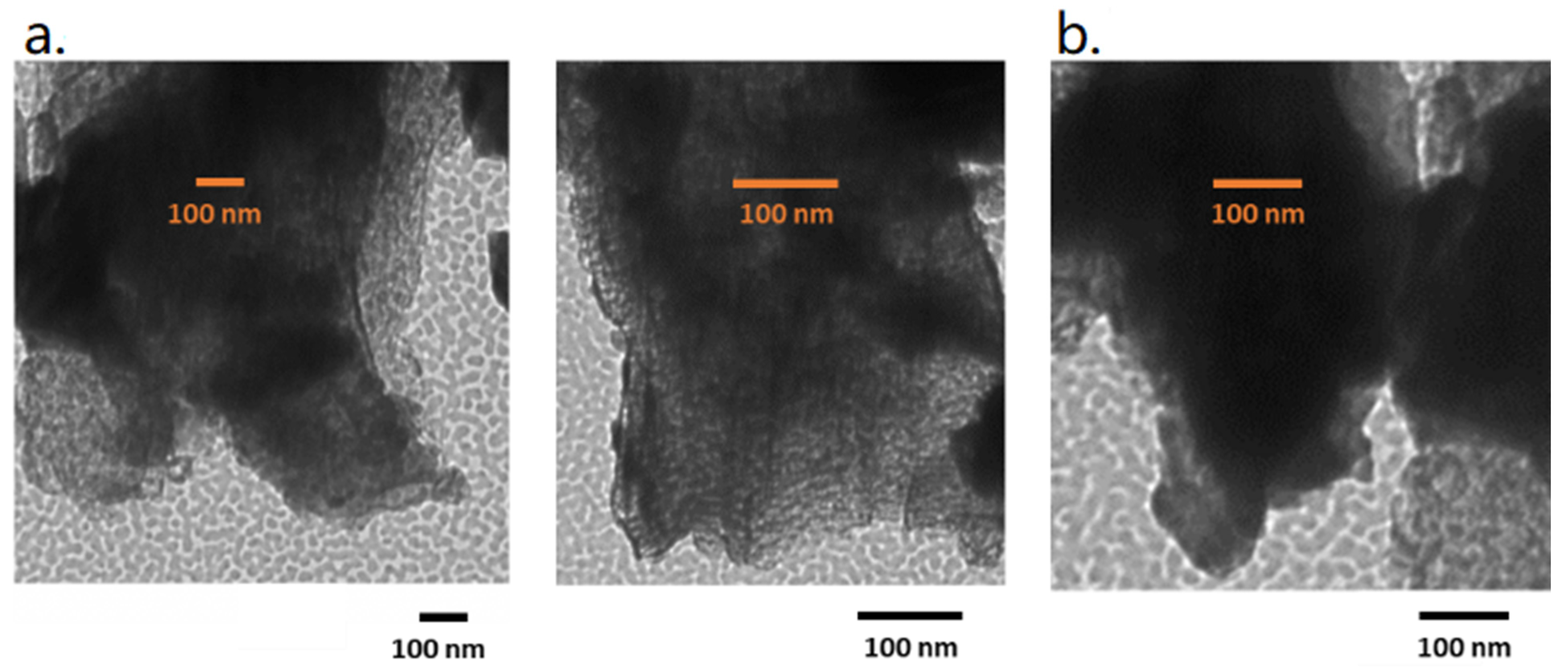
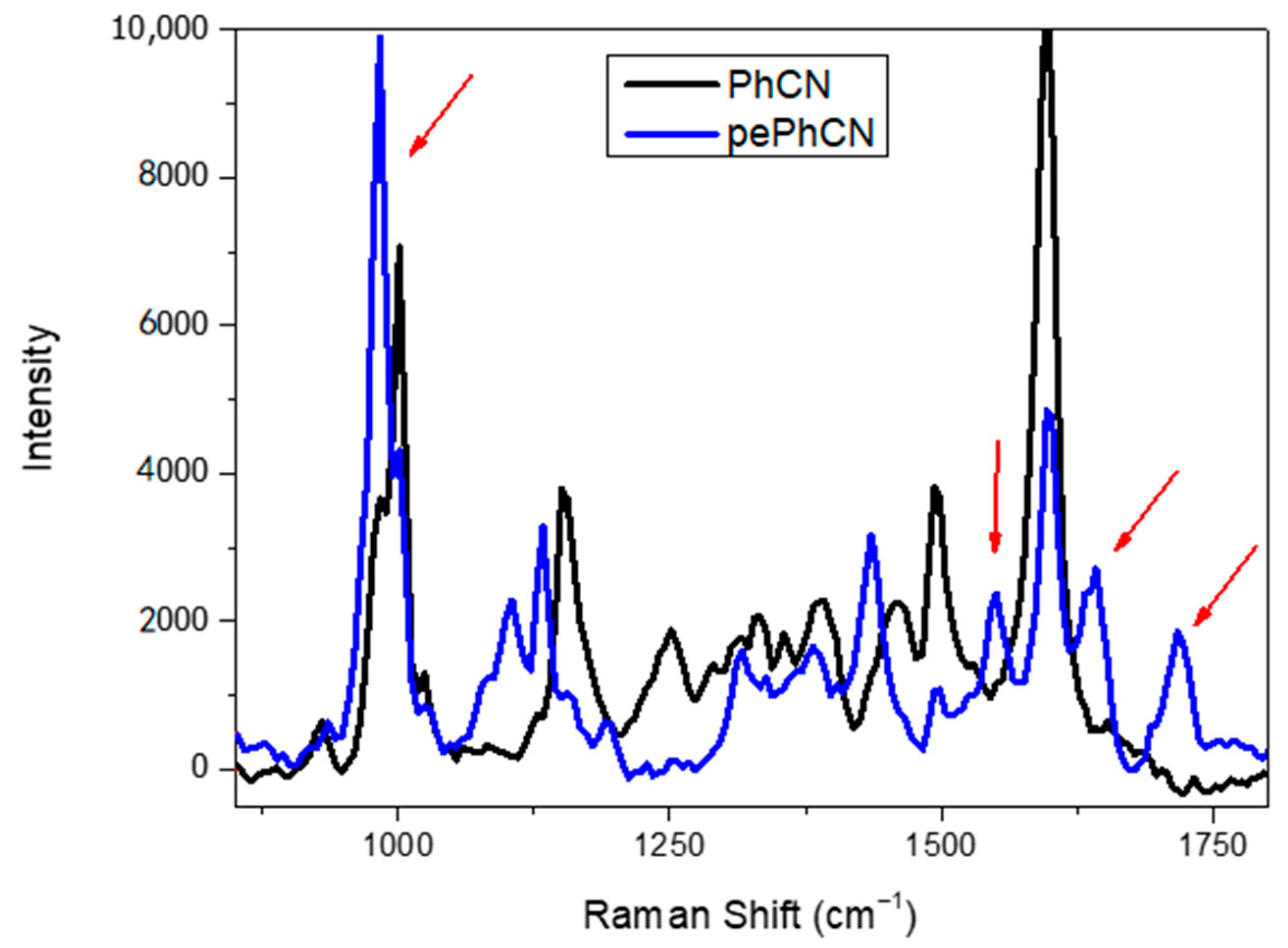
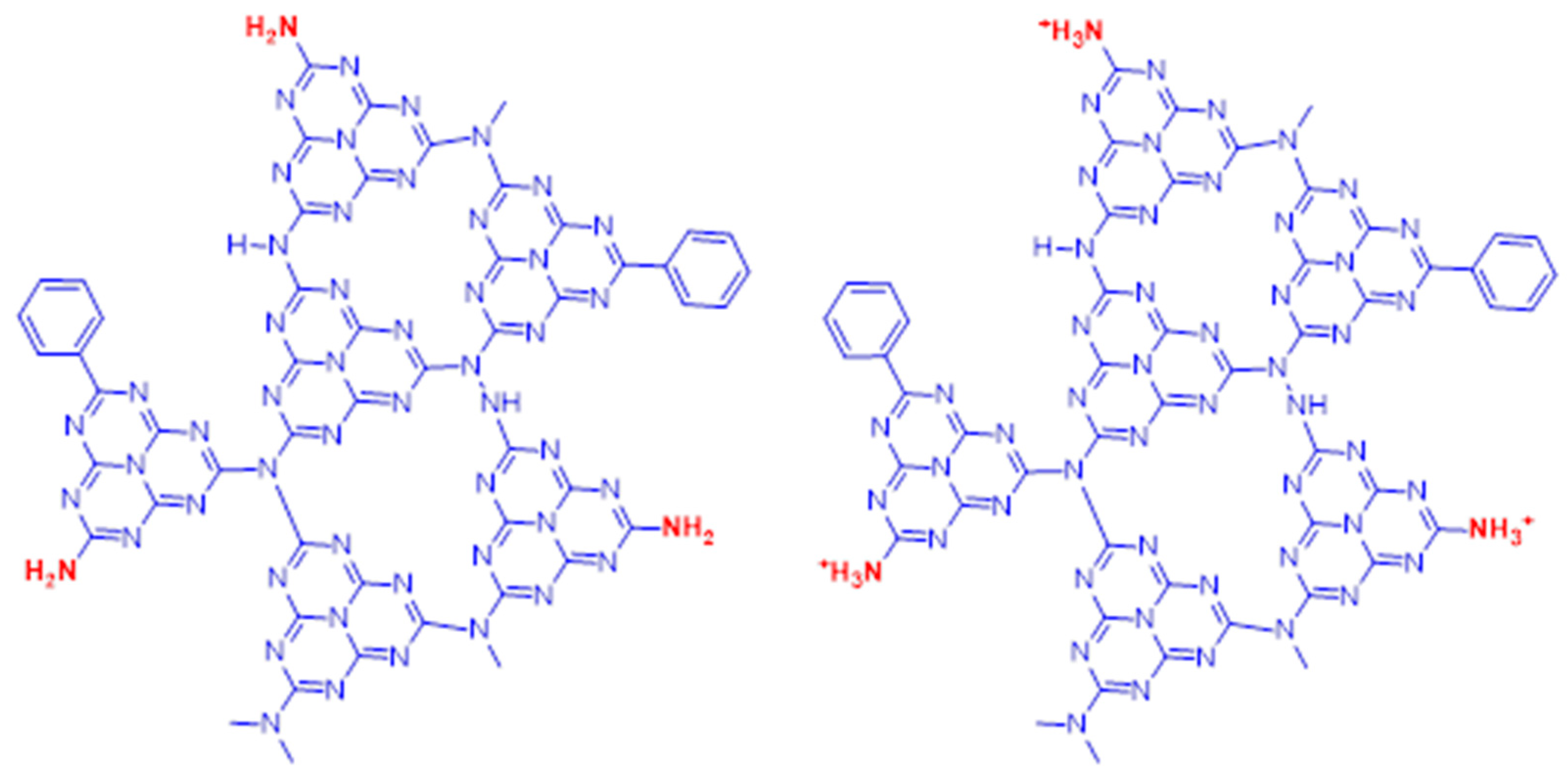
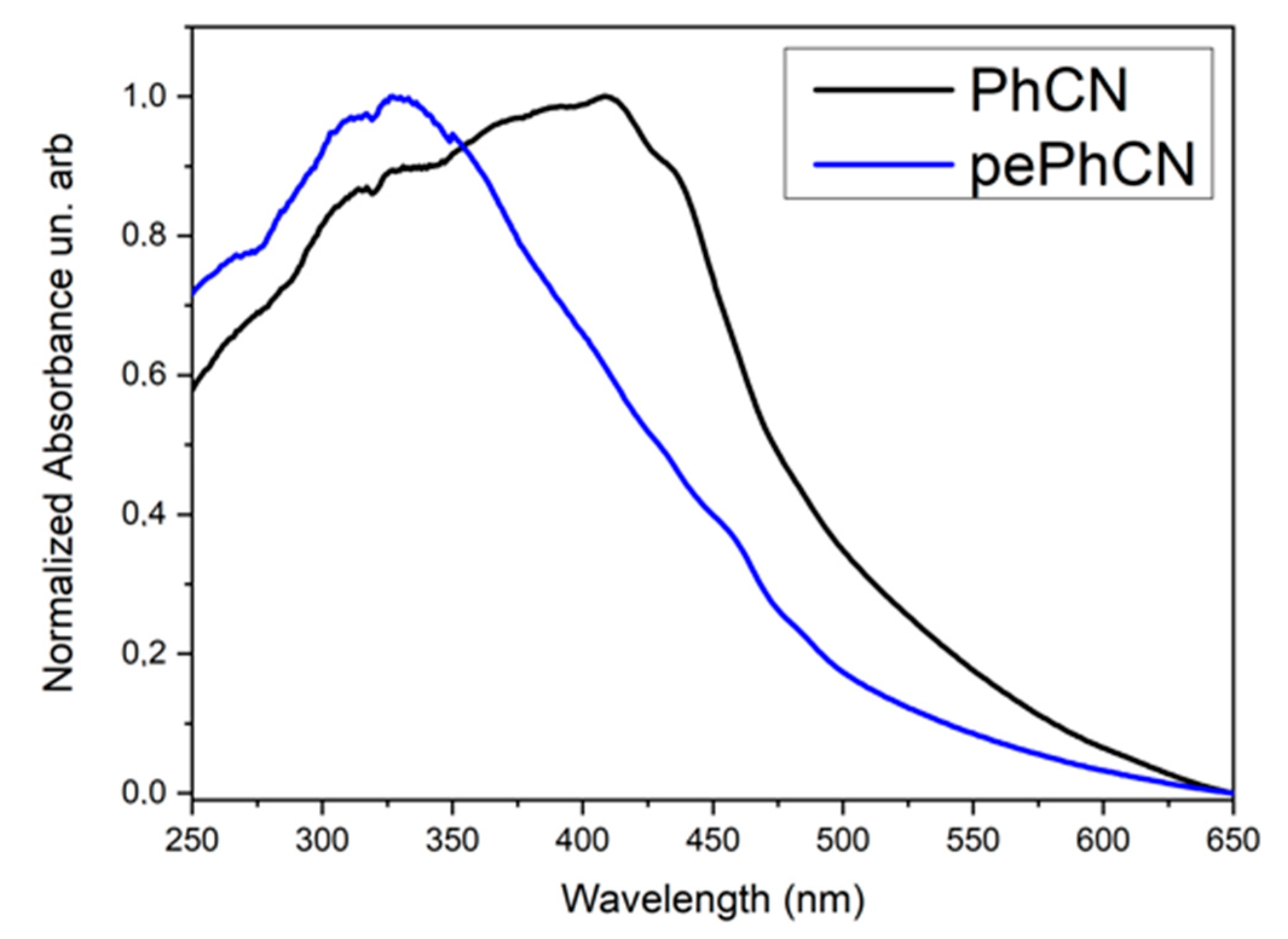

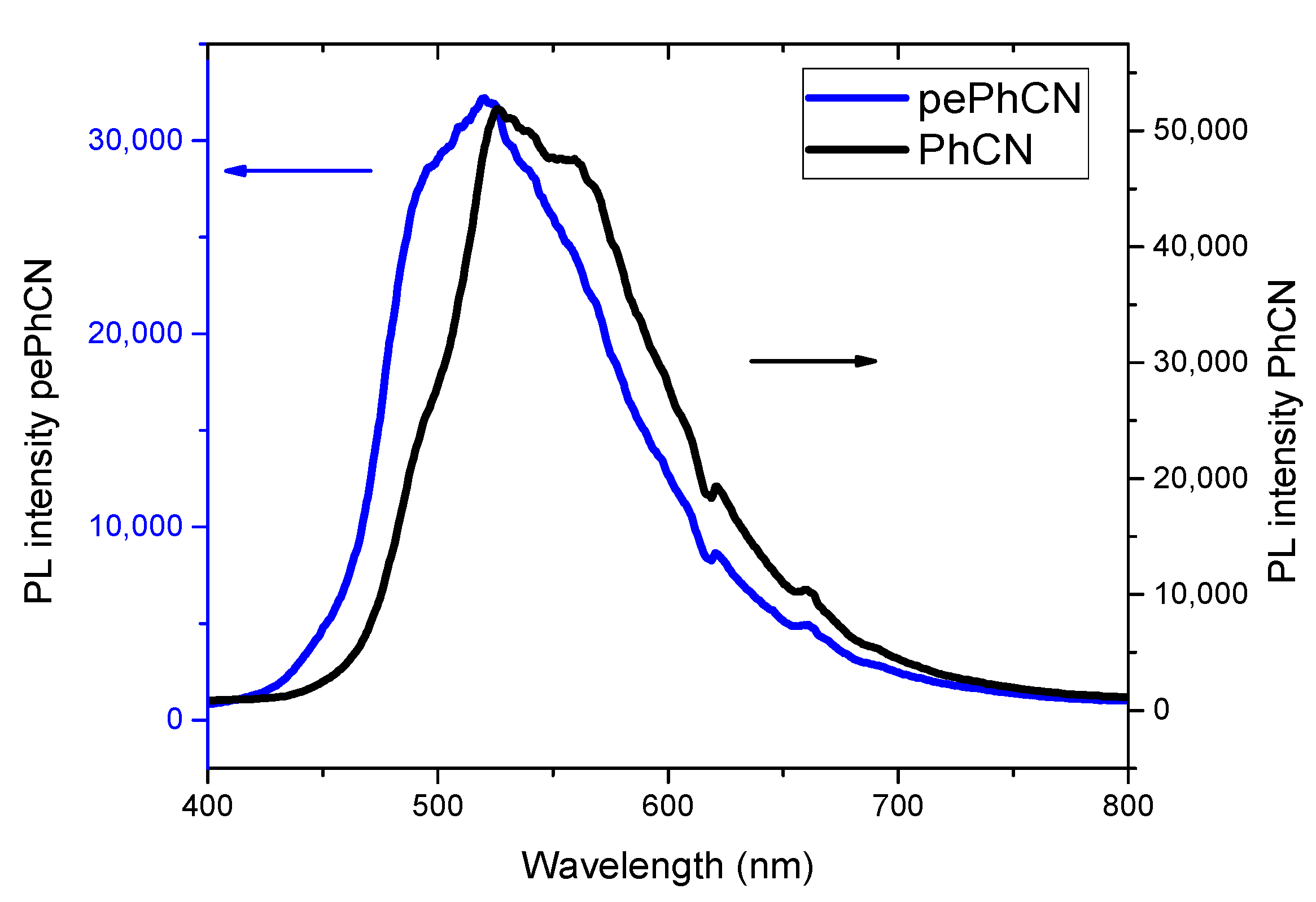


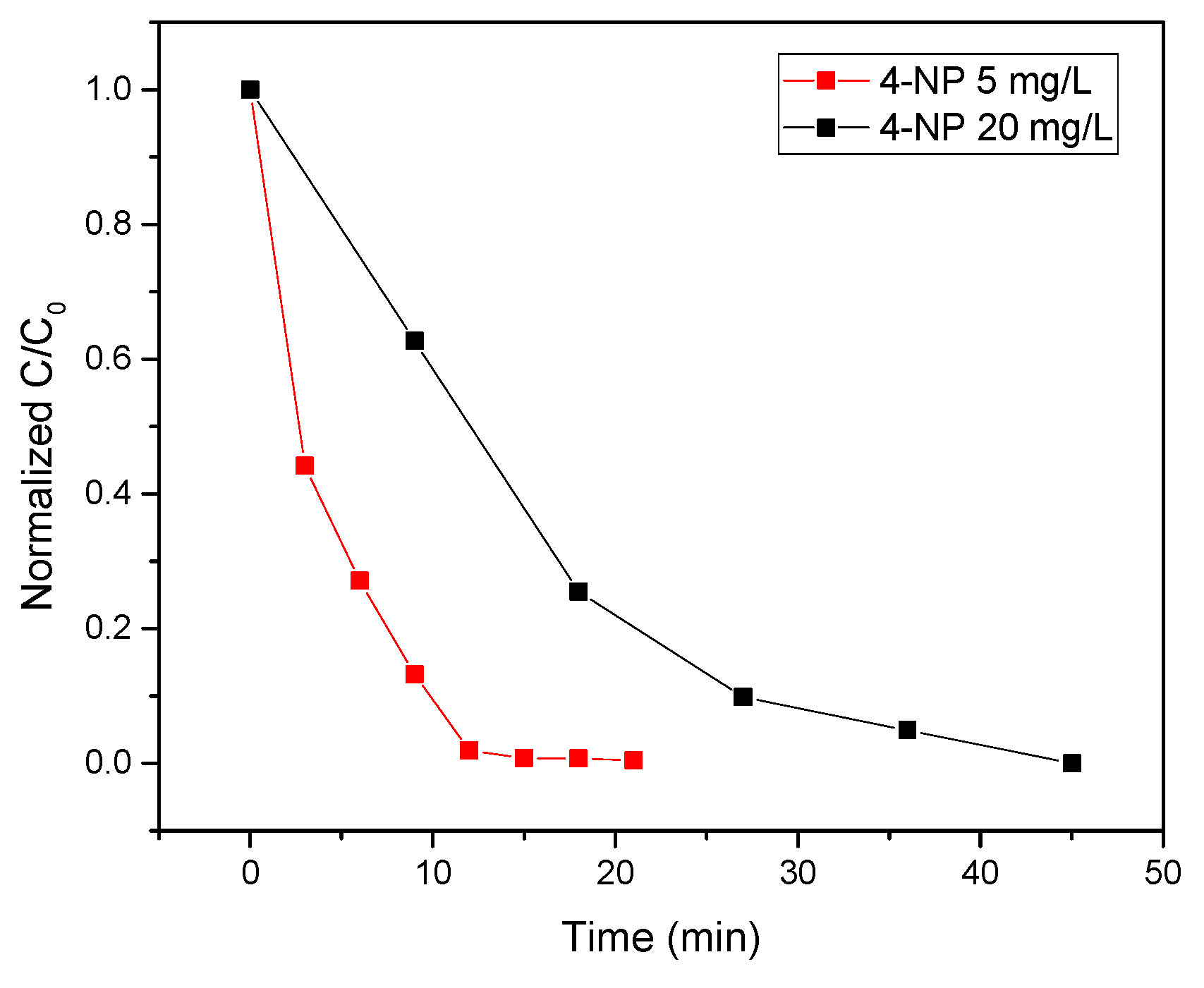
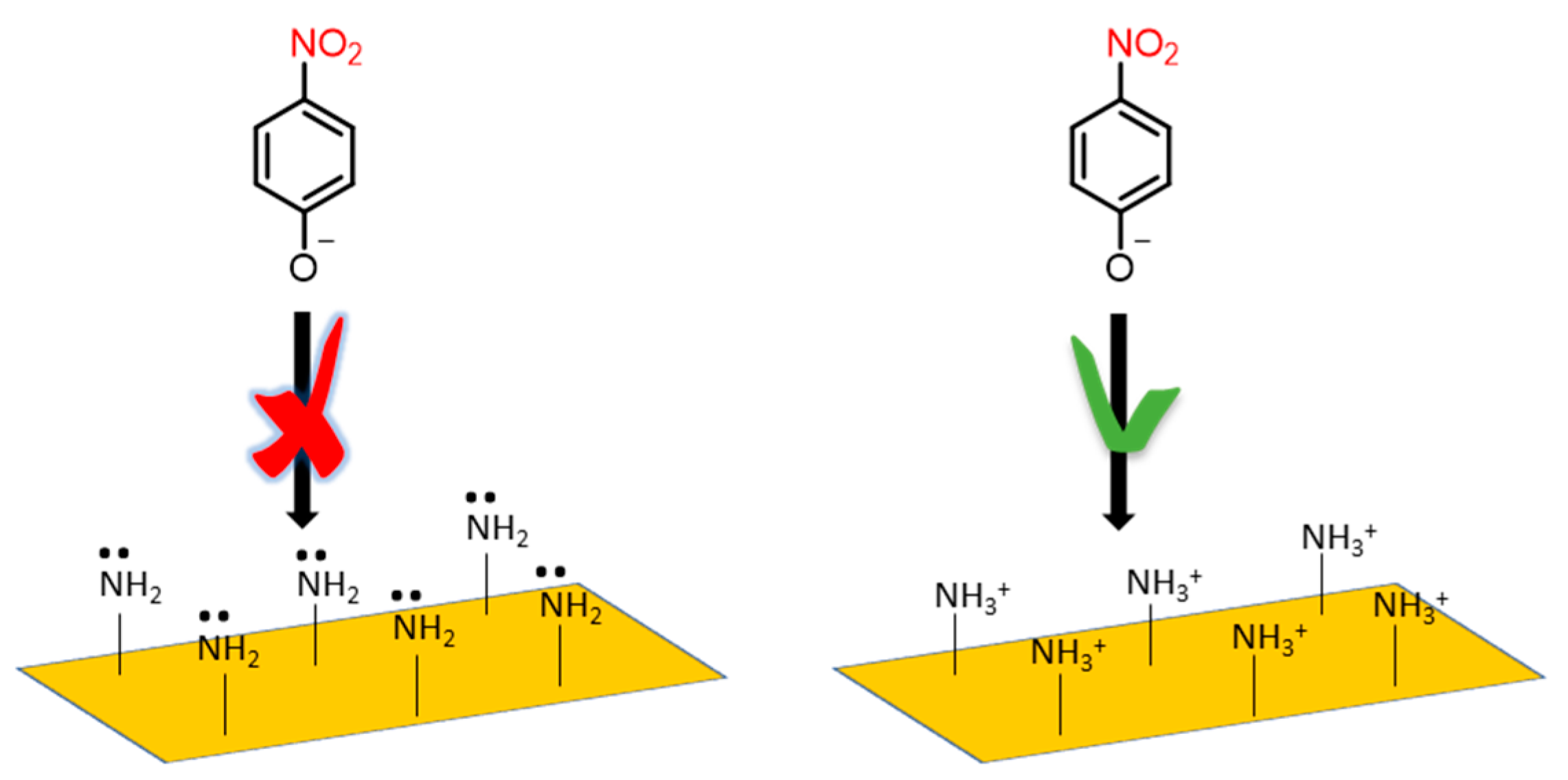
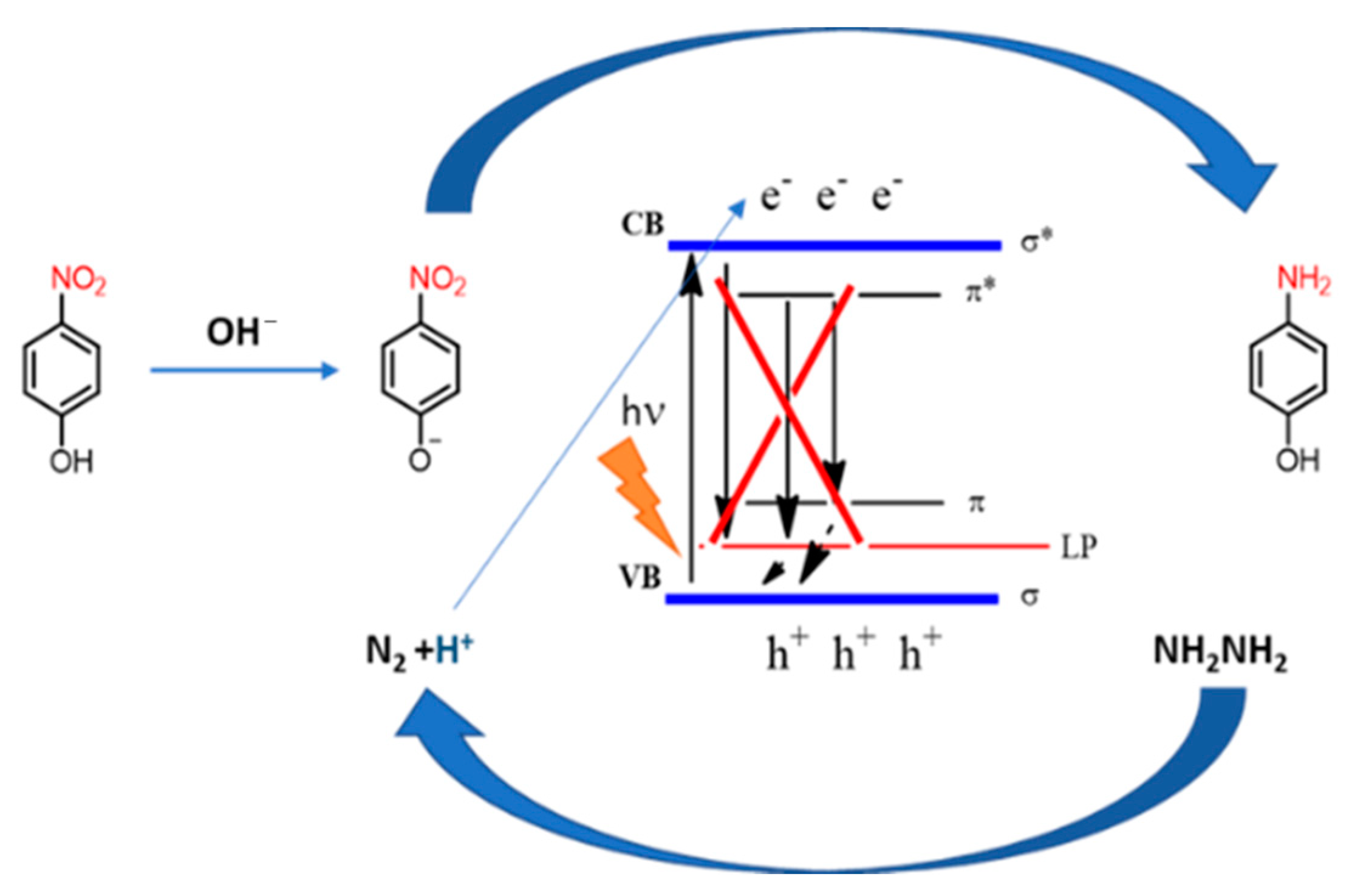
Publisher’s Note: MDPI stays neutral with regard to jurisdictional claims in published maps and institutional affiliations. |
© 2021 by the authors. Licensee MDPI, Basel, Switzerland. This article is an open access article distributed under the terms and conditions of the Creative Commons Attribution (CC BY) license (https://creativecommons.org/licenses/by/4.0/).
Share and Cite
Porcu, S.; Secci, F.; Abdullah, Q.A.; Ricci, P.C. 4-Nitrophenol Efficient Photoreduction from Exfoliated and Protonated Phenyl-Doped Graphitic Carbon Nitride Nanosheets. Polymers 2021, 13, 3752. https://doi.org/10.3390/polym13213752
Porcu S, Secci F, Abdullah QA, Ricci PC. 4-Nitrophenol Efficient Photoreduction from Exfoliated and Protonated Phenyl-Doped Graphitic Carbon Nitride Nanosheets. Polymers. 2021; 13(21):3752. https://doi.org/10.3390/polym13213752
Chicago/Turabian StylePorcu, Stefania, Francesco Secci, Qader Abdulqader Abdullah, and Pier Carlo Ricci. 2021. "4-Nitrophenol Efficient Photoreduction from Exfoliated and Protonated Phenyl-Doped Graphitic Carbon Nitride Nanosheets" Polymers 13, no. 21: 3752. https://doi.org/10.3390/polym13213752
APA StylePorcu, S., Secci, F., Abdullah, Q. A., & Ricci, P. C. (2021). 4-Nitrophenol Efficient Photoreduction from Exfoliated and Protonated Phenyl-Doped Graphitic Carbon Nitride Nanosheets. Polymers, 13(21), 3752. https://doi.org/10.3390/polym13213752








